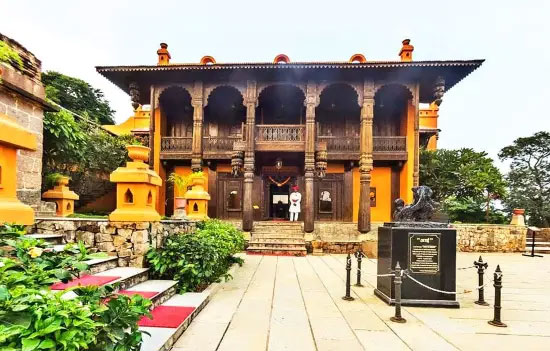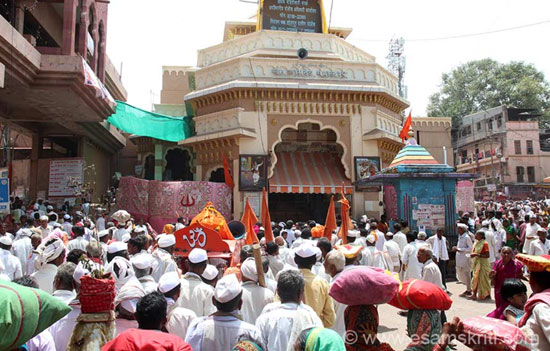- Know about the life and achievements
of a brave and loyal Subedar who served the Maratha state for nearly 40 years
and lived in the 18th century.
In the
annals of Maratha history, there were many who managed subas, but just two men
who were identified as ‘subedar’. The first was Pilaji Jadhavrao, who served
the Maratha state from 1712 to his death around 1751, and the second was the
redoubtable Malharji
Holkar.
The period of 1680-1707, i.e. the Maratha war of
independence against the Mughals, is the fate changing phase of Indian history.
Many Maratha warriors and Sardars emerged as protectors and repulsed Mughal
invasions successfully. After this phase, the new Mughal emperor released
Chhatrapati Shahu in 1707 (grandson of Shivaji Maharaj. He was captured with
his mother Yesubai
and kept in captivity for about 17 years by Aurangzeb. Yesubai was released in 1719)
When Chhatrapati Shahu
returned to Maharashtra and ascended the throne of Satara in 1708, he was
opposed by Maharani Tarabai and her loyalists. Chhatrapati Shahu emerged
victorious and expanded the Maratha Empire. During his reign many Maratha
Sardars dedicated their lives for expansion of Hindvi Swaraj, Subedar Pilaji Jadhavrao was one of them. He became
the sword arm of Maratha Empire just like the Patwardhans.
The period 1713-1753 was, for the Marathas, a period of wars.
Pilaji was the main force behind many wars and achievements.
Not much is known about the childhood of Pilajirao. He was a descendant of Lakhuji Raje Jadhavrao, who was the direct descendant of Seunas of Devagiri. His father was a Patil (village head) of village Wagholi near Pune and had two sons Pilaji and Sambhaji. Pilaji lost his father when he was a child.
Pilajirao was one of the Maratha Sardars who went to
Delhi for release of Chhatrapati Shahu (held in captivity by the Mughals) and played
a key role in his release. Impressed with his wit and wisdom Chhatrapati Shahu rewarded
him with land on Dive Ghat (in and
around Pune).
On his return from Mughal captivity the accession of
Chhatrapati Shahu was not smooth. During 1707-1713 he faced opposition from Maharani
Tarabai (wife of Shivaji’s son Rajaram (from his second wife, who ruled from
Kolhapur) and her loyalists Maratha Sardars (for e.g. Damaji Thorat, Chandrasen
Jadhav, Udaji Chavhan). Pilaji and Peshwa Balaji Vishwanath subdued these rebel
chieftains and secured the throne for Chhatrapati Shahu.
Hereafter, Pilaji turned his attention to the Portuguese.
Kanhoji
Angre was the arch enemy
of foreign powers like British, Dutch and the Portuguese. After many
unsuccessful attacks the British and the Portuguese joined hands to fight Kanhoji
Angre. Their joint army, numbering more than 7500+ with skilled soldiers with
lots of ammunition, started proceeding towards Kulaba.
When Kanhoji Angre got this news he immediately asked
Chhatrapati Shahu for help. Shahu sent Pilaji with 2,500 soldiers. On 20
December 1721, Pilaji attacked the combined forces of British and Portuguese. In
a decisive engagement Pilaji’s forces defeated the Portuguese and forced them
to retreat. On the other hand, Kanhoji defeated British army.
Thus, the British and Portuguese had
to retreat. At the same time Bajirao Peshwa arrived
with any army of 20,000. Thus, the British and Portuguese had to agree to a peace
treaty with the Marathas.
Credit must go to Pilaji and Angre, whose victories
prevented these two European powers from capturing Kulaba.
 Jadhavgarh Fort near Pune is now a hotel
Jadhavgarh Fort near Pune is now a hotel
The Portuguese would harass the Hindu population in their
dominion. This angered Chhatrapati Shahu, who ordered Subedar Pilaji to subdue
them. So Pilaji attacked the Portuguese province of Thane in 1723. His
march remained unopposed towards Vasai. He won many parts in this march. This worried the Portuguese who
agreed to a peace treaty at Cambay in 1724. (Cambay is modern Khambat in
Gujrat).
However, inspite of the 1724 treaty the Portuguese
continued to harass the local population and began to challenge Chhatrapati
Shahu. Once again, Pilaji defeated the Portuguese. Thus in 1730 he won cities
of Daman and Diu.
He also won Kohaj Fort (i.e. on
the Palghar-Wada road) and in a fierce battle against the Portuguese
at Manor, he emerged victorious. After this he laid siege on Cambay and won.
But now, the Mughals had started attacking Marathas in the
North. The Marathas did not want to fight a two-front war. So a peace treaty
was signed between the Marathas and Portuguese in 1732 at Bombay now Mumbai.
Still the Portuguese continued their earlier activities so
the Marathas became determined to uproot the Portuguese. Subhedar Pilaji marched towards Mahim (in
modern day Mumbai) with an army of 7,000 and was later joined by warriors like the
great Chimaji
Appa and others. Eventually in the Battle of Vasai the Portuguese
surrendered to the Marathas in 1739. Subedar Pilaji’s role in the Vasai
campaign was noteworthy.
Against Siddi
Siddi of Janjira were a vassal of the Mughals. He held
control of many important forts like Anjanvel, Gowalkot, Mandavgad, Raigarh
etc. Siddi Saad, the chief of Anjanvel, held a grudge against Bramhendra Swami
(Guru of Peshwa) so he destroyed Parshuram temple in 1727. Shahu sent Pilaji to
subdue Siddi but movements in Malwa (Marathas were surrounded by Mughals and
their allies in Malwa province) were restricted. So to avoid a two front war
they dropped this campaign against Siddi.
In 1734-35, Chhatrapati Shahu sent Pilaji and Chimaji
Appa to subdue Siddi. But due to pre-occupation in North India, the campaign
against Siddi was discontinued. Later, Subedar Pilaji captured Bankot and
defeated Siddi in the Battle of Mahad. Next with the help of Chimaji Appa, he besieged
the strong fort of Gowalkot and decisively defeated Siddi in the Battle of
Rewas (1745). With Gowalkot fort captured, it ended the supremacy of Siddi
completely.
Post Shivaji there were two seats of Maratha power,
Satara and Kolhapur. Chhatrapati Shahu ruled from Satara. Descendants of Queen
Tarabai referred to above ruled from Kolhapur. The Peshwas were with the Satara
rulers.
Against Nizam
The Nizam of Hyderabad was an arch enemy of Marathas. Initially
he dare not oppose them openly but later planned to attack and depose Shahu with
the help of Sambhaji of Kolhapur. Aurangabad was under the Nizam. Many
Maratha Sardars were unable to subdue the Nizam in Aurangabad. However, over a period of two months
Pilaji engaged and defeated the Nizam. Thus, he added Aurangabad (1725) and areas
such as Ambad, Uruki Kannad to the Maratha Empire.
When Bajirao Peshwa engaged in the Battle of Palkhed
(1728) Pilaji played an important role. He attacked Aurangabad which forced the
Nizam to abort his plans of attacking Pune. The attack on Aurangabad by Pilaji was
a strategic move because the Nizam was dependent on vast ammunition which he
left behind. The sudden attack by Pilaji on Aurangabad forced the Nizam to give
up his plans of destroying Pune. Later, the Nizam suffered defeat.
Campaign in North India
After repulsing Mughals in 1707 and securing the throne for
Chhatrapati Shahu, Marathas turned their attention towards the north. In 1722
and 1726 Pilaji and Bajirao Peshwa marched deeper in Malwa.
In 1728, Pilaji along with Chimaji Appa (brother of
Bajirao) defeated Daya Bahadur (Mughal Subedar of Malwa) in the Battle of Ujni.
While in Malwa Kayem Khan Bangash, son of Muhammad Bangash, attacked Subhedar
Pilaji with an army of 3,000. But he was easily defeated by Subedar Pilaji and
retreated to save his life. Pilaji got enormous amount of booty from the retreating
forces.
In 1734, Pilaji subdued Datiya, Orchha (near Gwalior) etc.
which frightened the Mughals since these areas are close to Delhi. The Emperor
dispatched Mir Atish and Khan Durran to fight the Marathas in Malwa. In Sironj,
Pilaji defeated the Mughal army and forced them to retreat. Because of these
battles, the Mughal emperor experienced prowess of the Marathas.
In 1735 a Mughal army under Mir Bakshi and Kamruddin Khan
attacked the Marathas. Subhedar Pilaji along with Ranoji Shinde and Ghorpade
engaged them in continuous wars. 2-3 battles were fought between the two armies.
However, in the Battle of Wodsha, the Marathas under Pilaji defeated the Mughals
decisively and forced them to retreat. Khan sought refuge in the fort of Orchha
and had to bribe the Marathas with five lakhs rupees before they retired.
Pilaji made collections in the parganas
of Shivpuri, Kolaras, Pohari and Narwar before returning.
Subedar Pilaji also played a great role in the first Battle
of Delhi (1737), which was fought against the Mughals and the Battle of Bhopal
(1738), which was fought against combined the armies of Nizam, Mughals and
their allies. Both these battles were important as they ended the hegemony of
Mughals/Nizam. Thereafter, Malwa became part of Maratha Empire.
The deaths of Bajirao Peshwa in 1740 and Chimaji Appa a
few months later dealt a severe blow to the Maratha Empire. Nana Saheb became the
new Peshwa. The enemies were still able and trying to uproot Marathas. During
these difficult times Pilaji stood, like a rock, behind Nana Saheb and guided
him in campaigns.
In the northern campaigns of Peshwa Nana Saheb, Pilaji
helped in every possible way. In the Bhelsa/Bhilsa Campaign of 1744, Pilaji
captured Ratangarh (near Datia in modern day Madhya Pradesh). This victory secured Maratha
influence in Bundelkhand and Malwa.
He also accompanied the Peshwa in his Karnataka campaign
and showed that at the age of 66-67 he could fight like young soldiers. Pilaji
played the role of a mediator between Peshwa and Raghuji Bhosale of Nagpur.
This is a separate topic by itself so beyond the scope of this article.
Along with his military career, Pilaji was also a master
in the art of peace. He was a friend to all Maratha Sardars, also known as Ajaatshatru (person who don’t have
enemies). Peshwa Bajirao, Nana Saheb, Chimaji Appa and Sadashiv Bhau respected
him as a fatherly figure. Pilaji was closest to Chhatrapati Shahu.
Pilaji established a fort and village known as Jadhav
Vadi. It had a population of up to 7000 then, many of whom were martyred in
third battle of Panipat. He established Peth
(business lines) at Vagholi, Jadhav Vadi , Saswad and Diwa. He was a devout
Vaishnava, devotee of Panduranga of Pandharpur. He built numerous temples such
as Vyaghreshwara temple. (Wagholi i.e. 20 kms from Pune. Pilaji’s memorial
is situated here too)
 Vitthala Mandir, Pandharpur.
Vitthala Mandir, Pandharpur.
Pilaji died in 1751 at the age of 71 after serving the
Maratha Empire for about 40 years. During this period he defeated the British,
Portuguese, Siddis, Mughals and the Nizam. He also helped expand the Maratha
Empire.
Inspite of having large amount of land in various places he
did not crave or create a separate state like the Holkars (Malwa) and Shindes
(Gwalior). In fact his descendants are not spoken of today-no fancy palaces
like those of the Holkars and Shindes. There is a Jadhavgarh Fort near Pune. Pilaji
remained loyal to the Chhatrapati till his last breath.
It will not an exaggeration to call Pilaji Jadhavrao the “Sword
Arm of Maratha Empire.”
Sources and reference
1. Contribution of Pilaji Jadhaorao to Maratha Power by S
A Jadhavrao.
2. New history Of Marathas Volume 2 by G S Sardesai.
3. Military System of Marathas by S N Sen.
4. Kanhoji Angre Maratha admiral by M Malgonkar.
5. Maratha relationship with major states of Rajputana by
R K Saxena.
6. History of Maratha people volume 2 by C A Kincaid.
To read all
articles by author
Also read
1. 5 minute video on Pilajirao
in Marathi
2. Bajirao
Peshwa – The Empire Builder
3. The
extraordinary exploits of Chimamaji Appa
4. The
Maratha Century